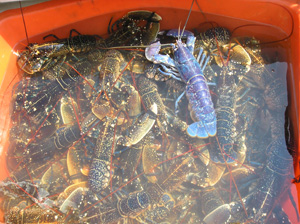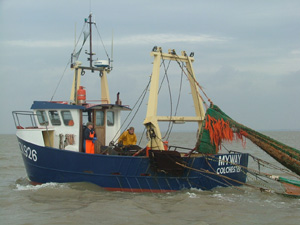Fishing
Over 165 commercial fishing vessels registered in Essex
Today, fishing and aquaculture remains a pivotal part of Essex coastal life. There are over 165 commercial fishing vessels registered in Essex, and every port has its own fleet of charter vessels which take parties of recreational anglers out to the farthest reaches of the Thames Estuary.
Most commercial vessels now operate from Harwich, West Mersea, or Leigh-on-Sea but some sail from smaller ports or sheltered creeks which make up much of the Essex coastline. A wide variety of gear is used in the area, with trawls and drift or fixed nets being used to take finfish, whilst pots and dredges are used for shellfish.
Produce
 Fishing boats traditionally target cod, whiting, herring, and sprat during the winter months, and the summer is spent fishing for bass, sole, and thornback ray (known locally as roker). Many other species are also fished commercially as estuarine and coastal habitats form some of the most productive regions of the sea. Most of the boats are under 10 metres in length and operate with crews of one or two. Catches are mostly exported or transported to local retail outlets but significant quantities are also sold on stalls or in local markets.
Fishing boats traditionally target cod, whiting, herring, and sprat during the winter months, and the summer is spent fishing for bass, sole, and thornback ray (known locally as roker). Many other species are also fished commercially as estuarine and coastal habitats form some of the most productive regions of the sea. Most of the boats are under 10 metres in length and operate with crews of one or two. Catches are mostly exported or transported to local retail outlets but significant quantities are also sold on stalls or in local markets.
On the fishing grounds, the commercial fleet are joined by a flotilla of angling boats emerging from ports and rivers across the county, some are chartered, but many are privately owned.
These boats target mainly cod, smooth-hound, bass, tope, roker, and mackerel. Shore angling too is immensely popular and the county of Essex has much to offer with an array of piers, harbours, creeks, estuaries and sandy beaches. This offers a variety of fishing opportunities and habitats which is a major draw to beginners and experienced anglers alike and is a valuable asset to the local economy as anglers often travel great distances to enjoy their sport.
The shellfish industry also makes a significant contribution to the local economy. A combination of aquaculture and wild harvesting yields significant quantities of Pacific and native oysters as well as mussels and clams. The jewel in the crown however is the Thames Estuary Cockle Fishery. This fishery, which is predominantly based on the Maplin Sands from Shoeburyness to Foulness, is the largest cockle fishery in Europe.
Key organisations
 The Thames Estuary Cockle Fishery is managed by KEIFCA, Kent and Essex IFCA with an annual Total Allowable Catch (TAC) being set. This ensures a sustainable fishery and is based on the results of biannual surveys with over 1000 shellfish samples being taken covering an area of approximately 120 km2.
The Thames Estuary Cockle Fishery is managed by KEIFCA, Kent and Essex IFCA with an annual Total Allowable Catch (TAC) being set. This ensures a sustainable fishery and is based on the results of biannual surveys with over 1000 shellfish samples being taken covering an area of approximately 120 km2.
The Kent and Essex IFCA also plays a key role in marine conservation by engaging with stakeholders and the general public, responding to consultations, and facilitating dialogue over how best to manage marine resources into the future.
